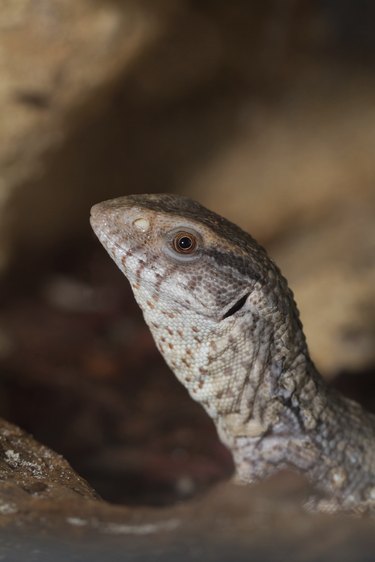
Sexing most monitor lizards (Varanus spp.) is difficult, and savannah monitors (V. exanthematicus) are no exception. Adult males often exhibit slight physical differences from females, but these differences are often subtle. Accordingly, the most helpful visible clue for determining a monitor's sex is the presence of hemipenal bulges, located under the tail base. In practice, it is often impossible for novices to determine sex with certainty, but a qualified veterinarian can examine your lizard's internal sex organs. Such efforts usually yield definitive answers, but exceptions do exist.
Anatomical Differences
Video of the Day
Male lizards have paired reproductive organs, termed hemipenes. They hold these organs internally, inverted inside the base of the tail, when not in use. Most female monitors possess analogous organs of indeterminate function, called hemiclitori. Mature males also possess ossified structures, known as hemibacula, inside their hemipenes. In many mature male specimens, the hemipenes produce twin bulges along the bottom of the tail, near the vent.
Video of the Day
Most methods of determining gender rely on trying to evert, visualize or otherwise verify the presence of hemipenes. However, you can try to interpret other physical traits. For example, mature male savannah monitors are usually larger than females are, and have larger heads and wider tail bases. However, without knowing the age of the animal or having an animal of the opposite sex to which you may compare, these differences are of little practical value.
Manual Eversion
Some keepers attempt to evert their lizard's sex organs by applying pressure to the base of the tail. While experienced hands may achieve successful eversion, some males may be able to resist the process, thereby causing the specimens to be incorrectly identified as females. Further complicating matters, females may evert their hemiclitori, which can be difficult to distinguish from hemipenes. Only experienced keepers or veterinarians should attempt eversion, as it may cause serious damage if improperly executed.
Palpating Via Probe
Some keepers try to verify the presence of hemipenes by introducing a smooth, lubricated, stainless steel probe into the vent. Conceptually, by determining the depth to which the probe may penetrate freely, you can deduce the presence of one set of sexual organs or the other. When inserted correctly, the probe passes either into one of the inverted hemipenes or into one of the hemiclitori. Hemipenes are typically longer than hemiclitori, so the probe should penetrate more deeply in males than in females.
This technique is widely used to determine the gender of snakes and a few lizard species accurately, but it is not always effective with monitor lizards. The potential for damage exists when executed by novices, so heed the dry, but apt, advice of monitor lizard expert Daniel Bennet, in his book "A Little Book of Monitor Lizards": "In general, it is best not to interfere with the genitals of your lizards."
Endoscopic Examination
The most accurate method available for determining your lizard's gender is to have your vet visually examine the internal gonads. To do so, your vet will make a small incision in the monitor's belly, inflate the cavity with air, and visualize either ovaries or testes. A potential bonus of this procedure is that your vet may notice early signs of internal disease, which he can then treat, allowing you to avoid future health problems.
Experimental Methods
Scientists, veterinarians and keepers are constantly experimenting with new techniques for determining the genders of monitor lizards. Although not applicable for most field research, scientists and veterinarians often use X-rays or ultrasound to determine the sex of lizards. In 2009, Danny Brown of Queensland, Australia, published a report in "Biawak," detailing his use of high-powered lights to illuminate the tail bases of captive monitors, thereby allowing the animals' genders to be determined. Other researchers, such as the team led by J.G. Smith of Charles Darwin University, Darwin, Australia, have sought to devise a method for determining monitor sex that relies on body measurements, although their study focused exclusively on Australian species.
Sex-Related Husbandry Considerations
While the husbandry of both males and females is largely similar, it is important to provide adult females with a substrate suitable for egg deposition, as even females who do not mate with males may deposit infertile eggs. Without a place to deposit their eggs, the lizards will retain them, which can create serious health problems. Therefore, you must provide all specimens that you cannot be certain are male deep particulate substrate, such as soil, clay or a mixture of the two.
- Reptiles Magazine: Monitor Sexing and Breeding
- Mampam Conservation: Sexing Monitor Lizards
- Biawak: Hemipenal Transillumination as a Sexing Technique in Varanids
- Journals of Zoo and Wildlife Medicine: Determination of Sex in White-Throated Monitors (Varanus Albigularis), Gila Monsters (Heloderma Suspectum), and Beaded Lizards (H. Horridum) Using Two-Dimensional Ultrasound Imaging
- Reptiles Magazine: Breeding Savannah Monitors
- Exotic Pet Vet: Reptiles: Reproduction "From Egg to Adult"
- Journal of Herpetology: Can Morphometrics Predict Sex in Varanids?